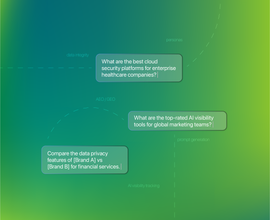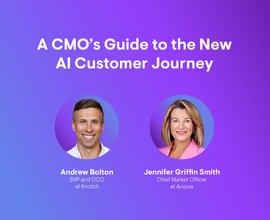Your Guide to Measuring Technical AI Search Readiness
Achieving AEO success requires moving beyond traditional SEO tactics and embracing a proactive, real-time monitoring strategy.
As answer engines operate at a new speed, brands need 24/7 intelligence into their technical health, AI crawlability, content accessibility, and performance to ensure they are seen as a trusted source by AI. This means instantly identifying issues like crawl gaps, JavaScript rendering problems, and poor Core Web Vitals.
Learn how Conductor's monitoring platform helps you analyze technical AI search readiness, identify critical optimization opportunities, and future-proof your visibility in the age of AI search.
Is your AEO/GEO strategy actually working? How can you be sure? As AI reshapes the search landscape, the dashboards and KPIs you’ve relied on for years are starting to show an incomplete picture. Traditional metrics like keywordKeyword
A keyword is what users write into a search engine when they want to find something specific.
Learn more rankingsRankings
Rankings in SEO refers to a website’s position in the search engine results page.
Learn more and organic clicks don't tell you if AI bots are crawling your site or if answer engines see your brand as a credible, authoritative source.
Without a new way to measure AI search readiness and performance, you’re flying blind. You can't prove the value of your efforts or diagnose why AI crawlersCrawlers
A crawler is a program used by search engines to collect data from the internet.
Learn more or answer engines might be ignoring your content. Success in this new era requires a shift in measurement—from tracking outcomes (like traffic) to monitoring the foundational signals of trustworthiness that AI crawlers are looking for.
Crawlability is step one, but measuring whether AI search engines actually pick up and reward your content is step two. This guide provides a new framework for AEO measurement that covers both crawlability and AI search readiness and shows you exactly how to track these critical signals in Conductor Monitoring.
Are AEO/GEO and SEO success metrics the same?
The short answer is: yes and no. At the core of AEO/GEO, the goal is still to ensure your brand is visible in search and drives engagement digitally. But since the way people search is changing, traditional SEO metrics don’t tell the whole story.
As the industry shifts from SEO to an AEO/GEO-first strategy, the metrics used to measure success are shifting, too. Historically, digital strategies hinged on keyword-based rankings and organic clicks.
Now, visibility within AI-generated responses and summaries like Google’s AI Overviews is emerging as a primary performance indicator. Brands can’t just track their search rankings. They need to monitor mentions, citations, and references across AI outputs, as well as the rise of AI referral traffic.
The future belongs to those who can expand beyond basic rankings and meet their audience where they are.
What metrics should I use to measure my AI search readiness?
Generally, there are a few key metrics that give insight into your AI discoverability. Specifically, these are the segments that you’ll want to pay attention to when measuring whether your content is set up to be found, mentioned, and cited by AI.
- Performance score: Measures your site’s technical foundation and user experience.
- Publish date: Measures how fresh your content is.
- Schema & structured data: Measures how easy it is for AI crawlers to view and understand your content.
- Author: Measures how authoritative your content is based on the topical and domain authority established by a specific author.
- Log file & Crawling: Measures whether AI crawlers are visiting your site at all, how often they are, and when their last visit was.
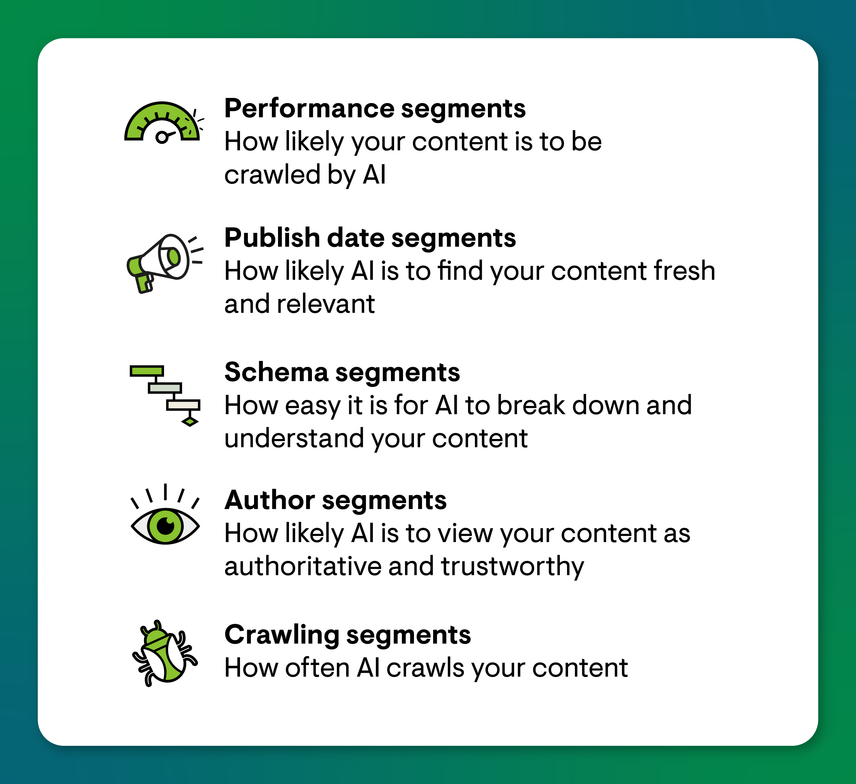
These metrics all give you a window into how fresh, well-structured, and technically sound your content is, all of which impact your AI discoverability. If your content isn’t set up to be discoverable, it’s very unlikely that your content will be visible and perform well in AI search.
How can I measure my AI search readiness?
The most important thing you need to do in order to measure your AI search performance is to make sure that your content can be crawled by AI. If it can't, your content won’t perform at all, because it won’t be visible in AI search.
But once your content is crawlable, how do you make sure answer engine and search engineSearch Engine
A search engine is a website through which users can search internet content.
Learn more crawlers are actually visiting your content? And how do you see which pieces of your content are getting the most visits and attention from crawlers? These pieces of information are key in showing you where you have a chance to optimize some content and which pieces of your content are strong on their own.
Want to know how to measure whether AI bots can crawl your content? Check out our Guide to Measuring AI Crawlability in Conductor.
Invest in a real-time monitoring platform
Conductor Monitoring is built to track your site 24/7, so you can take action before your traffic, revenue, search visibility, and customer experience are impacted, while platforms with manual or scheduled crawls leave you with no new insights until the next crawl is complete. That’s not sustainable for companies that rely on brand authority and visibility to fuel conversions. Those companies need to resolve issues ASAP, and only real-time monitoring can facilitate that.
Getting your brand to show up in AI search is really going to come down to whether or not you have a technology that can give you visibility into where you're mentioned and where you're cited by AI.
Key Conductor Monitoring features that indicate AI search readiness
Measuring AI search readiness in Conductor Monitoring is powered by two specific features: real-time alerting and custom metric segmentation.
Real-time alerting notifies you of any issues that arise on any pages on your site, the moment they’re detected.
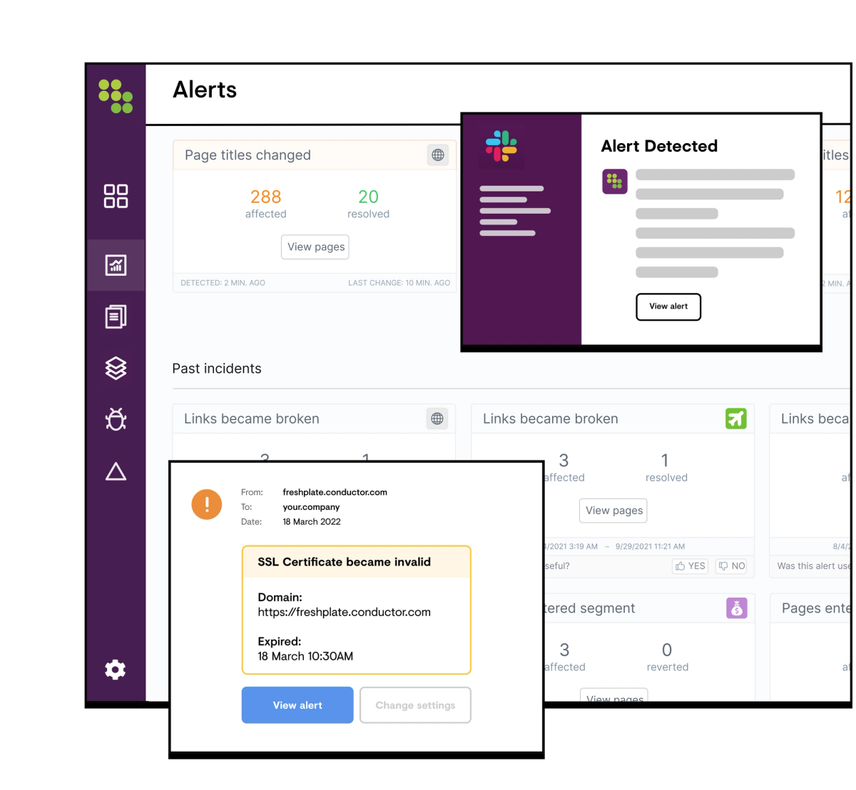
From there, these issues are prioritized based on impact so you can take action on what matters most. That helps you keep your performance and technical health strong.
Custom segmentation allows you to create custom dashboards that track the metrics that are most important to your enterprise AEO strategy. This gives you a one-stop shop view of your AI performance across key monitoring metrics.
Here are some of the key segments to pay attention to when building out your dashboard. We’ll dive deeper into how to measure each of these specific metrics within Conductor Monitoring down below.
- Performance drops: Customers with a Conductor Lighthouse Web Vitals integration can view their UX performance score based on Core Web Vitals that measure aspects of your site like loading speed and image and content rendering. If this number is low, it means that your UX could use improvement, which will make it less likely for answer engines to crawl your content and less likely that it will be mentioned or cited by AI.
- Missing Schema: Schema, AKA structured data, is one of the single most important factors in maximizing AI visibility. It helps LLMs break down and understand your content. In Conductor Monitoring, you can filter your content based on whether or not there’s structured data within the article. Apply a filter to your custom dashboard to include Schema.org items. Any articles missing Schema will appear, so that you can optimize with structured data.
- Crawl gaps: Crawl gaps speak to downtime where AI crawlers aren’t visiting or revisiting your site. We illustrated this dynamic in our guide to Measuring AI Crawlability, where we compared how frequently AI crawlers and traditional crawlers visited one of our pages. If we had gone back this week and seen that AI hadn’t visited the page in a couple of weeks, that would have clued us in that there’s something to investigate.
Want to know how to build and edit your own custom segments in Conductor Monitoring? Check out our helpful guide to custom segmentation .
How to measure AI search readiness in Conductor Monitoring
Again, the evolution toward AI-driven search has completely changed traditional digital success metrics, demanding a fresh approach to understanding brand visibility and impact.
With answer engines now shaping how people search and how brands are found, the industry has responded by defining new benchmarks that reflect AEO success, from technical considerations to how brands are referenced, cited, and presented by AI.
Let’s dive into how exactly you can measure your site’s AI search discoverability using Conductor Monitoring.
Performance score segments
Why performance scores matter for AEO: Your performance score in Conductor Monitoring is based on Google’s Core Web Vitals framework. A high performance score indicates that your site displays strong UX. That tells answer engines that your site provides a fast, reliable experience, making you a safer and more credible source to cite.
For example, we’ve created custom segments within Conductor Monitoring to track pages within our site (conductor.com) that have a Core Web Vitals performance score greater than 50. If any page falls below that score, we’re alerted so that we can look into what caused the drop and develop a plan to optimize it. There isn’t a firm rule that says any performance score below 50 won’t rank or get cited in search, but remember why your performance score is important: it speaks to user experienceUser Experience
User experience (or UX for short) is a term used to describe the experience a user has with a product.
Learn more. If your UX isn’t optimized, your audience won’t want to visit your site, search and answer engines won’t promote it, and you’ll be leaving money on the table.
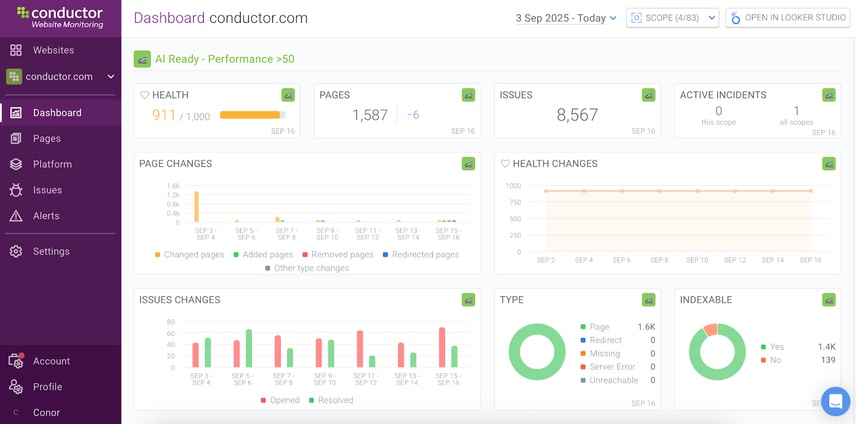
You might look at the image above, see the strong health score, and think that these pages are ready and optimized for AI search. What can we really learn from this page? Check out the Pages module that shows six pages have recently fallen below a performance score of 50. From there, you can follow the thread to see what pages dropped below this score, and learn why.
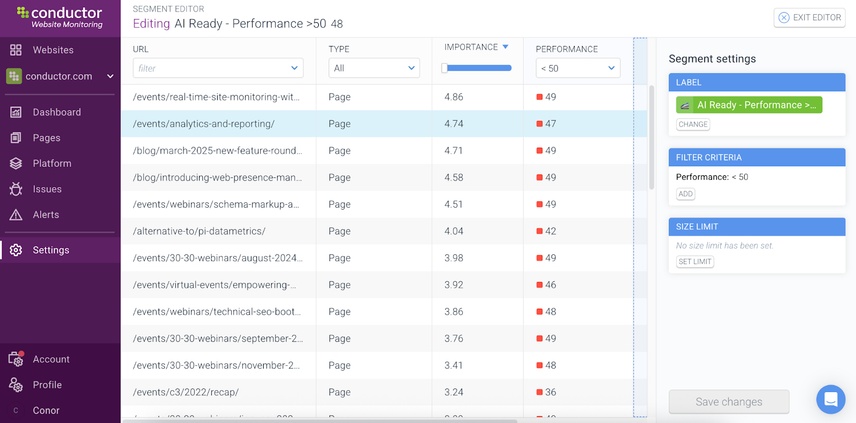
Once you’ve set up your custom filter, you can see which pages are showing a poor performance score, prioritize the most important ones, and dive deeper into why performance is down and what’s causing it.
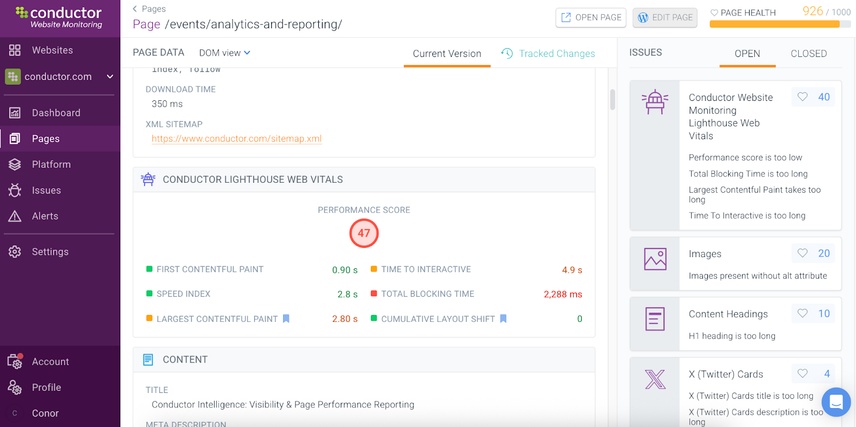
Publish date segments
Why publish dates matter for AEO: A recent publish date signals to answer engines that your information is current and, therefore, more trustworthy, increasing its value as a source for accurate, up-to-date answers.
The date your content was published is an important factor in potential AEO success because, as we established, LLMs can crawl your content very fast and, if they’re inclined to, very often. If your content is outdated or stale, then the LLM is going to register that the content isn’t as recent or helpful as other sources out there.
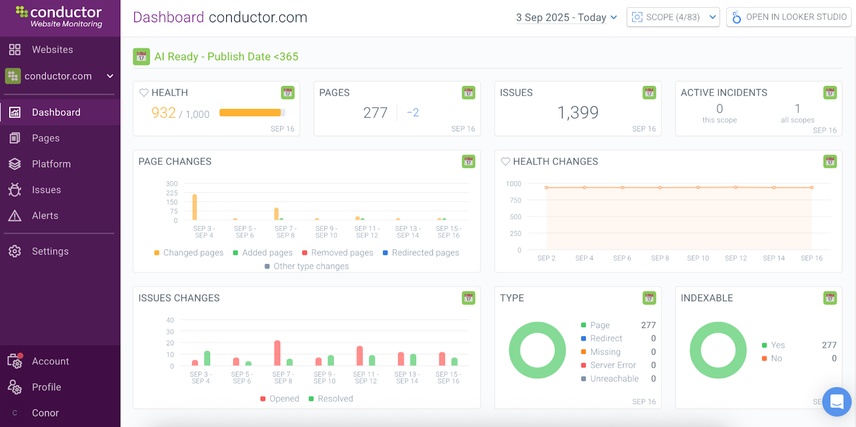
Within Conductor Monitoring, you can track your content by the date it was published so that you get alerted when pages reach a certain age. For instance, we have a segment set up for our site that tracks pages published more than 1 year ago. Depending on the content, it gives us a pretty good idea of where updates or optimizations might be needed.
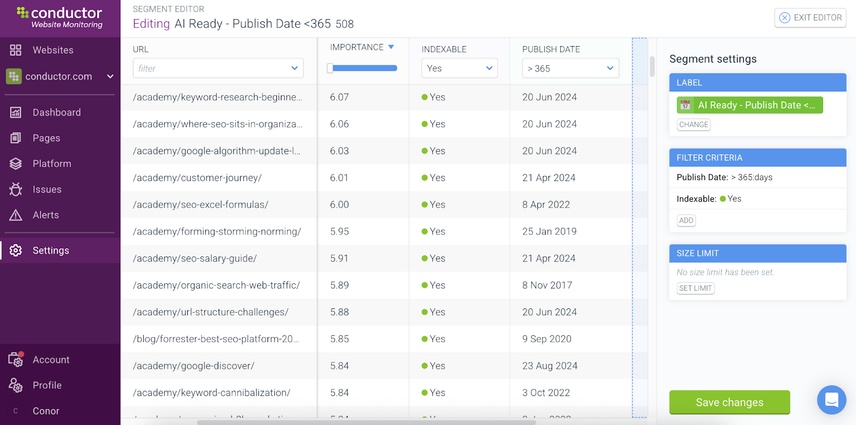
For example, say that you run an internet security software company, and you have multiple data-driven reports that dive into phishing scams by industry, the content is only as strong as its data.
If you haven’t updated the data, stats, or links in those reports within the last year or longer, then that’s likely not the best source for that information anymore, and one of your key thought leadership reports is unlikely to be picked up in AI search.
Schema & structured data segments
Why schema matters for AEO: Schema acts as a machine-readable roadmap for your content, removing ambiguity and allowing AI crawlers to understand key information with maximum speed and confidence.
Schema markup is arguably one of the most important factors in driving AEO success. LLMs don’t read and digest content the same way that we do, and similar to Google, schema helps signal what a piece of content is, making it easier for the LLM to crawl and understand.
LLMs won’t spend resources endlessly crawling a page; they want to move quickly so they can get the information they need and provide an accurate answer for the user.
Another custom segment you can create is around structured dataStructured Data
Structured data is the term used to describe schema markup on websites. With the help of this code, search engines can understand the content of URLs more easily, resulting in enhanced results in the search engine results page known as rich results. Typical examples of this are ratings, events and much more. The Conductor glossary below contains everything you need to know about structured data.
Learn more. We have one set up for our conductor.com domain so that we’re alerted anytime a page is published that doesn’t have relevant schema markup.
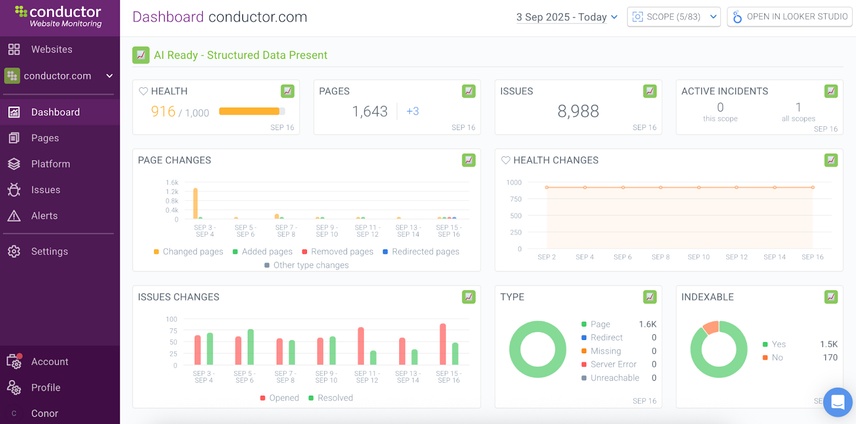
Some of these pages may not have schema by design; not every single page on your site necessarily needs schema markup. For example, say that you have a landing page designed to thank users for making a donation, you’re not expecting to get any organic visitors to that page or make it visible in search surfaces, so it won’t need schema.
But your high-impact pages should have schema to make it easier for answer and search engine bots to crawl, understand, and promote the content properly. Conductor Monitoring gives you insight into whether your key pages have schema or whether you should add it.
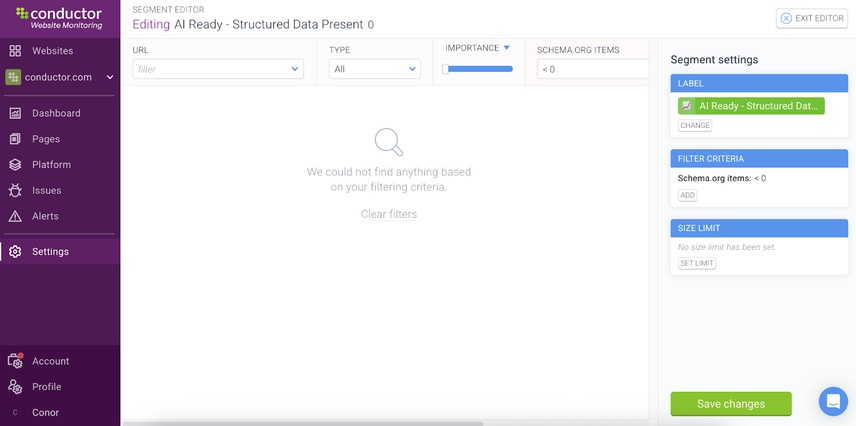
Thankfully, as you can see above, our key pages all have schema markup of some kind, but if any pages are missing structured data, we get a Conductor Monitoring alert so that we can add any necessary schema to the page.
Author segments
Why authorship matters for AEO: Authorship directly signals expertise and authority, connecting your content to a real person and aligning with the E-E-A-T principles that answer engines value when selecting trusted sources to cite or mention.
Along similar lines to schema, another way to track the AI-readiness of your site is by ensuring that all of your relevant content has an author associated with it. This is all about E-E-A-T, Google’s framework for creating helpful content. Authorship helps to build brand authority.
If you have an author on your page, then that signals to LLMs and Google not only that someone created the content, but they can then track that author through their index to understand what else that person has created and where their expertise lies.
Take our own Pat Reinhart, VP, Services and Thought Leadership at Conductor, as an example, if he writes a piece of content for our site, then an LLM would see all of the other content he’s created, the guest blogs he may have written for other sites, the webinars he’s hosted, and the quotes he’s given and understand that he’s a reliable source.
That also speaks to why it’s important to have author pages on your site to compile all of the content your subject matter experts have created. This gives LLMs an easy one-stop shop to establish an author’s expertise.
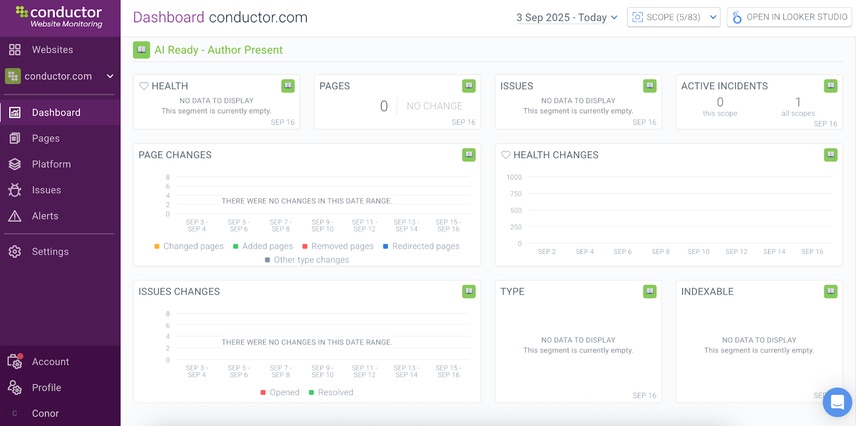
Conductor Monitoring helps you ensure that all of your relevant content has an author associated with it. As you can see above, all of the pages we’re tracking for this segment currently have an author listed, which is great. But if, for some reason, a page author was removed, we would get an alert to add the author back and investigate why it was removed.
Crawler visits segments
Why crawler visits matter for AEO: Crawler activity is your direct proof of visibility; frequent visits signal that AI finds your site valuable, while gaps can be the first warning of underlying technical or content issues.
The final segment we’ll cover is around crawl frequency. We spoke to this earlier, but it makes sense to create a segment to track crawler visits within Conductor Monitoring.
Tracking crawler visits shows you whether LLMs are coming back to your site, or if they visited it once and haven’t returned. This clues you into which of your pages could benefit from optimizations because if an LLM hasn’t visited in hours or even days, it could mean there are technical or content-related issues within the page, making them very unlikely to be mentioned or cited in AI search.
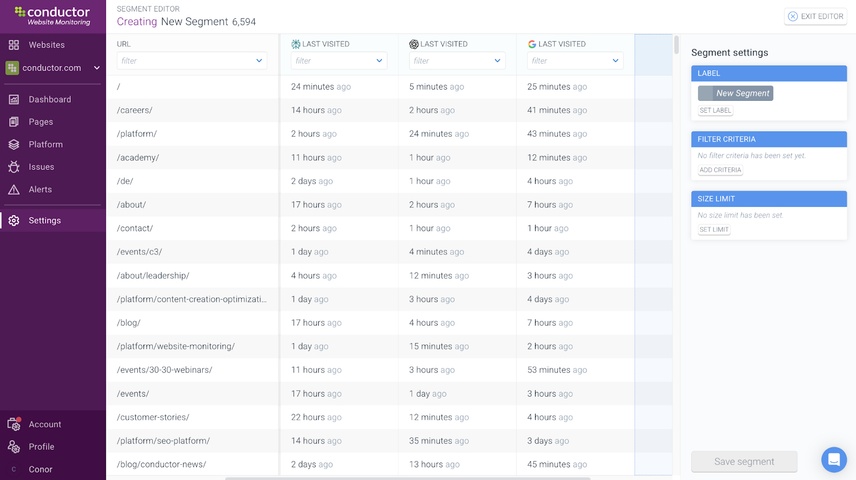
Real Conductor Monitoring success stories
So, we’ve detailed all the things Conductor Monitoring can do to ensure your AEO success, but what is the actual impact of these workflows? Just ask a few of our customers.
How a global automation leader reduced technical issues by 50%
One of our customers is a global leader in automation, helping to transform industrial manufacturing. As a global company, they have over 1 million distinct webpages and operate in more than 30 different locales.
It was a huge undertaking to crawl and monitor all of those pages on their own, especially considering the different languages and nuances of each locale. As a result, it would take the team days just to crawl their English US locale pages, which led to large blind spots in their audits and resulted in issues going unnoticed for extended periods of time. By the time they found the issues, their performance and visibility had already been affected in AI search and traditional search engines.
The team decided to leverage Conductor Monitoring, which crawled and monitored their content 24/7 across 1M+ pages, along with complex business and product segments. Conductor Monitoring alerted the team to any issues as they appeared, even prioritizing the issues to triage based on business impact. This made it seamless for the team to identify issues and take action to resolve them. Altogether, Conductor Monitoring helped the team reduce technical issues by 50% and improve their discoverability for answer engines.
How a UK energy provider drove a 191% increase in leads
A large UK-based energy company needed to more efficiently monitor their website performance and proactively identify technical issues. Previously, they relied on manual reviews of their content for technical issues, which meant issues often went undetected until they had already impacted performance in traditional search and AI answer engines.
Enter Conductor Monitoring, which helped the team by continuously monitoring every page of their site and alerting the team of issues as they were discovered. This freed up the team to focus on larger initiatives rather than spending resources on manual technical checks. As a result, the team saw a 191% increase in leads year over year and a 127% increase in engaged site sessions.
In the past five months, [Conductor Monitoring] has proactively identified several critical issues that could have negatively impacted our SEO performance and user experience… This proactive approach to technical SEO is a significant improvement over our previous reactive methods.
How a national insurance carrier boosted conversions by 324%
Another customer, a mutual insurance holding company based in Florida, was struggling to oversee and safeguard the technical health of the website. Specifically, UX issues started to appear on the site, affecting key product pages, which negatively impacted engagement and conversions. To address these issues, they leveraged Conductor Monitoring to monitor their entire site 24/7 and identify gaps within their technical strategies. This allowed them to pinpoint issues before they started to impact conversions and UX. As a result, the team saw a 324% increase in conversions year-over-year and a 40-point improvement to its overall technical health score.
How a major multimedia retailer ensured site-wide crawlability
An American multimedia retailer and television network that sells products, including clothing and electronics, was also struggling to make sure that its site was technically sound and that issues weren’t hiding beneath the surface.
Unfortunately, they had no way of knowing for sure outside of unreliable scheduled crawls. This led to technical issues and site changes going unnoticed, like pages for out-of-stock items remaining open, broken links, and canonicalization errors, which ultimately impacted their AI search and traditional search engine visibility.
With Conductor Monitoring, the team could monitor their site around the clock, ensuring their links worked properly, out-of-stock item pages were updated, and other issues were resolved ASAP to ensure crawlability and visibility across search experiences.
Building a proactive AI search readiness strategy
In Conductor Monitoring, you can not only view when a bot has most recently crawled your site, but you can also compare that against some of the other key segments we’ve gone over to get one clear performance view. For example, say that you wanted to see when ChatGPT most recently crawled a group of pages, and you want to see if factors like performance score, publish date, schema, and author presence are impacting that crawl frequency. You can set up a custom segment within Conductor Monitoring to get all that info all in one place.
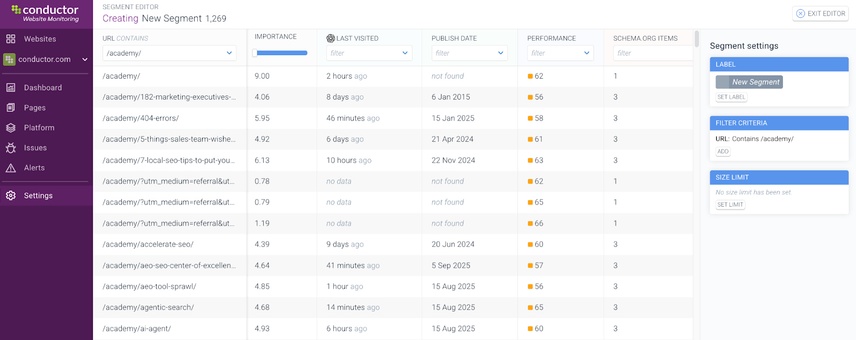
By leveraging a unified view of your AI search readiness within Conductor monitoring, you set the stage for seamless collaboration across SEO, content, development, product, and digital operations teams.
When everyone works from the same up-to-date insights, it eliminates silos and ensures consistent, data-driven decision-making. This shared perspective enables teams to address opportunities and challenges more efficiently, align on priorities, and respond with agility as search environments shift, which helps strengthen your overall AEO strategy.
How measuring AI search readiness fuels continuous improvement
The true power of measuring AI discoverability or readiness doesn’t just come from a static report or a monthly dashboard. It comes from creating a process where you’re continuously optimizing. It all starts with getting visibility into key technical health components, but visibility is meaningless unless it’s tied to action. Action is what drives growth. Each metric we’ve discussed informs how you take action to enhance your site's authority and technical health in the eyes of AI.
This process can be broken down into a simple feedback loop: Detect → Measure → Optimize.
- Detect: Real-time monitoring alerts you of issues that arise on your pages. For example, you detect that a group of your key product pages has suddenly stopped receiving visits from AI crawlers.
- Measure: Instead of guessing, use the platform to measure and diagnose the root cause. Say you dig into the product pages and notice a recent drop in their Performance Score, and see that a recent update is causing the pages to run slower.
- Optimize: Armed with this data, your team can optimize by fixing the issue. As you continue to monitor, you see the performance score recover and AI crawlers return.
This isn't a one-time fix; it's the engine of a proactive AEO/GEO strategy. By closing the loop between detection and optimization, you move away from reactive fire drills based on scheduled crawls and toward a more agile system that addresses and prioritizes issues in real time. Conductor Monitoring is the central hub for the entire cycle, providing visibility to detect issues and the analytics to measure their impact. This continuous process is key to tracking AEO/GEO success and actively building on it.
Measuring AI search readiness in review
The search landscape has fundamentally changed. Gone are the days when you could rely on scheduled crawls and traditional rank tracking to understand your online performance. As we've seen, answer engines move fast, and your brand's visibility can change in an instant. Staying ahead of the curve requires a new level of agility and insight that yesterday's tools can't provide.
That's where a proactive, enterprise AEO strategy, powered by real-time intelligence, makes all the difference. By keeping a constant pulse on AI crawler activity, performance scores, schema implementation, and author signals, you can stop guessing and start making data-driven decisions that protect and grow your presence in AI search.
Success in this new era isn't just about fixing what's broken; it's about building a resilient digital presence that answer engines trust and promote. By using the workflows we've covered, you can unite your teams around a single source of truth, turning reactive fire drills into a proactive strategy for sustainable growth

![Patrick Reinhart, VP, Services and Thought Leadership, [object Object]](https://cdn.sanity.io/images/tkl0o0xu/production/9bc72298b24ad01b732de4c3376f79546d20f81c-3542x3542.png?fit=min&w=100&h=100&dpr=1&q=95)

